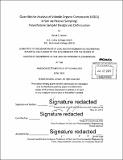| dc.contributor.advisor | Philip M. Gschwend, | en_US |
| dc.contributor.author | Jensen, David G. (David Gannon) | en_US |
| dc.contributor.other | Massachusetts Institute of Technology. Department of Civil and Environmental Engineering. | en_US |
| dc.date.accessioned | 2015-10-30T18:59:32Z | |
| dc.date.available | 2015-10-30T18:59:32Z | |
| dc.date.copyright | 2015 | en_US |
| dc.date.issued | 2015 | en_US |
| dc.identifier.uri | http://hdl.handle.net/1721.1/99601 | |
| dc.description | Thesis: M. Eng., Massachusetts Institute of Technology, Department of Civil and Environmental Engineering, 2015. | en_US |
| dc.description | Cataloged from PDF version of thesis. | en_US |
| dc.description | Includes bibliographical references (pages 53-55). | en_US |
| dc.description.abstract | The potential for the release of volatile organic compounds (VOCs) to our natural environment is pervasive. However, the ability to accurately measure and predict VOC soil vapor concentrations is still limited. A polyethylene (PE) quantitative passive sampler using performance reference compounds and deployed via a hand driven probe is proposed as a solution. Additionally, a 1D diffusion mass transfer model was developed in MATLAB to predict the mass uptake into the PE sampler over time. The model was then implemented to investigate the effects of PE size and deployment time on the detection limit of BTEX compounds. Preliminary testing of the deployment probe indicates that a design to secure the PE around the outside of a driven rod must include a protective cover over the PE during insertion. A perforated pipe design is suggested. After deployment and recovery, the PE is extracted into water. The extraction water is then analyzed by direct aqueous injection to GC/FID. The minimum concentration detectable in soil vapors, by this PE passive sampling method, was determined to be the product of the target compound's air-water partitioning coefficient and the analytical detection limit. Assuming a 5 ng/mL analytical detection limit, the minimum soil vapor detection limit for toluene was approximately 1.25 mg/m 3. This limit would be similar for all BTEX compound and is above sub-slab vapor intrusion screening levels for the more toxic compounds such as benzene. This indicates that direct aqueous injection provides insufficient sensitivity and that purge and trap concentrations of VOCs is likely needed. It was also determined that a PE sampler, with dimensions as small as 5"x5/8"x0.0005", could theoretically reach 10 mg/m 3 sensitivity within a 1 h deployment time. This result suggests potential applications of the sampler for rapid and accurate site characterization of BTEX compounds. | en_US |
| dc.description.statementofresponsibility | by David G. Jensen. | en_US |
| dc.format.extent | 72 pages | en_US |
| dc.language.iso | eng | en_US |
| dc.publisher | Massachusetts Institute of Technology | en_US |
| dc.rights | M.I.T. theses are protected by copyright. They may be viewed from this source for any purpose, but reproduction or distribution in any format is prohibited without written permission. See provided URL for inquiries about permission. | en_US |
| dc.rights.uri | http://dspace.mit.edu/handle/1721.1/7582 | en_US |
| dc.subject | Civil and Environmental Engineering. | en_US |
| dc.title | Quantitative analysis of volatile organic compounds (VOCs) in soil via passive sampling : polyethylene sampler design and optimization | en_US |
| dc.type | Thesis | en_US |
| dc.description.degree | M. Eng. | en_US |
| dc.contributor.department | Massachusetts Institute of Technology. Department of Civil and Environmental Engineering | |
| dc.identifier.oclc | 925484064 | en_US |
